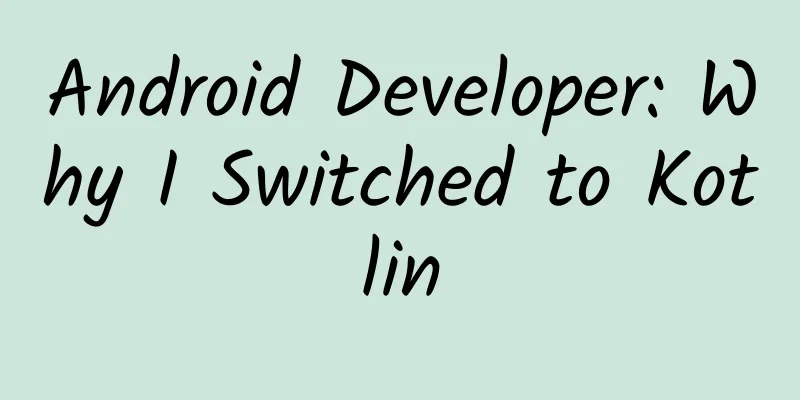Android Developer: Why I Switched to Kotlin

|
A word of caution, as a person who doesn't stay up late, I was overjoyed to find that Kotlin has become the official language of Android. In order to strike while the iron is hot, I decided to release the article that was originally scheduled for this Sunday three days in advance. I hope to let everyone know about Kotlin in time. I believe that many developers, especially Android developers, have heard of Kotlin to some extent. Of course, it doesn’t matter if you haven’t heard of it or are not familiar with it. Because this article and the content of the later blog will involve a lot of knowledge sharing about Kotlin. More than a month before writing this article, Flipboard China's Android project officially decided to use Kotlin as the project development language, which means that new code files will appear in Kotlin code format, and at the same time, old Java codes will also be translated into Kotlin code one after another. During the period of using Kotlin, I was shocked by its simplicity, efficiency, and speed, so it is necessary to write an article to talk about the characteristics of Kotlin. If I can achieve the effect of promoting Kotlin, I will be very pleased. Kotlin's resume
Coming from the well-known tool developer JetBrains, Kotlin's genes must contain features such as practicality and efficiency. Next, let's take a look at the characteristics of Kotlin, which is of course an important reason why I switched to Kotlin. Simple grammar, not verbose
Null Pointer Safety NullPointerException or NPE is the most common crash in our Java development program. Because in Java we have to write a lot of defensive code, such as this: NullPointerException is well solved in Kotlin.
The following code is an example of Kotlin's implementation of null pointer safety, and compared to the Java implementation, it can be done with just one line of code. Regarding the principles of null pointer safety, you can refer to this article to study some methods of learning Kotlin. Support method extension Often, the APIs provided by the Framework are often relatively atomic, and we need to combine them when calling them, because some Util classes will be generated. For a simple example, we want to display Toast information more quickly, and we can do this in Java. But Kotlin's implementation is amazing. We only need to rewrite the extension method. For example, the longToast method is extended to all Context objects. If we don't trace the source, we may not be able to distinguish whether it is provided by the Framework or extended by ourselves. Note: Kotlin's method extension does not actually modify the corresponding class file, but is processed by the compiler and IDE to make it look like we have extended the method. Lambda, higher-order functions, Streams API, functional programming support The so-called Lambda expression is an anonymous function, which makes our code simpler. For example, the following code is the application of lambda. The so-called higher-order function is:
Let's take an example of accepting a function as a parameter. In Android development, we often use SharedPreference to store data. If we forget to call apply or commit, the data modification cannot be applied. By using the function of higher-order functions in Kotlin, we can better solve this problem: Of course, in the above example we also used method extension to extend this feature. Kotlin supports Streams API and method references, which makes functional programming more convenient. For example, the following code combines Jsoup to crawl data from a proxy website. The code is simpler and faster to implement. String Templates Whether it is Java or Android development, we will use string concatenation, such as log output, etc. In Kotlin, string templates are supported, and we can easily complete the composition of a string array: Good interoperability with Java Kotlin and Java are both JVM-based programming languages. Kotlin and Java interact very well, and can be said to be seamlessly connected. This is reflected in:
Kotlin is widely used Kotlin has extensive support for Android application development, with many tools such as kotterknife (ButterKnife Kotlin version), RxKotlin, Anko, etc. Of course, there are also many existing Java libraries that can be used. In addition, Kotlin can also be compiled into Javascript. Recently, I wrote a code for grabbing proxy using Kotlin, which was very quick to implement. It is even much faster than pure JavaScript. About performance The execution efficiency of Kotlin is theoretically the same as that of Java code. Sometimes Kotlin may appear to be higher, for example, Kotlin provides an inline setting for methods, which can set some high-frequency methods for inline operations, reducing the overhead of stack push and pop and state saving at runtime. After reading this, do you want to try Kotlin? Its concise syntax, collection of many features, efficient implementation, etc. have already made it very popular abroad. Foreign companies such as Pintereset, Square, Flipboard, etc. have already begun to apply it in production. About switching to Kotlin In fact, before I made the decision (Kotlin had not yet been officially selected), I had considered whether choosing Kotlin meant giving up Java. But when I calmed down and thought about it, it was not the case, because the syntax of Kotlin and Java is too similar, and Kotlin is dealing with Java-related things all the time, so this concern is not a problem. It is usually not a difficult choice to switch to Kotlin for personal projects. After all, Kotlin is such an excellent language. I believe many people are still willing to try and use this language that can achieve twice the result with half the effort. The more difficult decision is how to get the team to switch to Kotlin. I think there are many reasons why it is difficult for the team to switch, such as learning costs, historical baggage, etc. But the root cause is actually a problem of mindset. Foreigners like to use tools to improve development efficiency because the labor cost is very high. The way for domestic teams to improve efficiency is usually to add members. Fortunately, Flipboard's US team has introduced Kotlin since 2015 (maybe earlier), so it is easier for the Chinese team to choose Kotlin. Of course, the more important thing is that the team is not large at present, and the members unanimously recognize the advantages of Kotlin. Regarding the method of switching to Kotlin in a team, the generally more feasible method is to promote it from top to bottom. This means that either the direct technical leader is more open-minded or someone needs to constantly promote it to influence the team. To make a more realistic comparison, Java is like a regular train that takes nearly 2 hours or even longer to travel from my hometown Baoding to Beijing West, while Kotlin is the high-speed train that takes only 40 minutes to reach the destination. Most people would choose the high-speed train because it saves time and improves the experience. This time and experience corresponds to high efficiency, high readability, and maintainability of code in programming. Now, with the support of Google, I believe that Kotlin to Android will be fully launched in the near future. To paraphrase Python's famous saying "Life is short, I use Kotlin", such an efficient and practical language should be accepted by more and more teams and applied to development and production. Of course, we also hope to shine in the domestic environment. The author of this article is Duan Jianhua, Android R&D engineer at Flipboard China. |
<<: Kotlin has become the new darling of Android after waking up [with code]
>>: Develop Android apps elegantly with Kotlin
Recommend
Volkswagen expands cooperation with Nvidia to cover more areas besides automobiles
According to foreign media reports, the German Vol...
Will I get pneumonia if I keep coughing after having a positive test? How to relieve cough? 10 questions about cough
Source: People's Daily The cover image of thi...
Japan increases subsidies for electric vehicles, but subsidies for fuel cell vehicles are still as high as 2.5 million
In the era of fuel vehicles, Toyota and Honda con...
7 Micro-Interactions to Improve User Experience
[[141728]] As we all know, we always judge a book...
It’s the end of the year, and we need to compete with event creativity again? Here is a thinking tool for you
At the end of the year, Christmas , New Year'...
Samsung S6 in iPhone's underwear reveals six surprises
Many details about Samsung's latest smartphon...
Why can't billions of stars illuminate the entire universe?
This ancient problem is known as Olbers' para...
Sogou Dictation will make stenographers unemployed. How many human fields will artificial intelligence invade?
Artificial intelligence is becoming the hottest t...
Short and sharp! 14 things to note when analyzing competitive products
What is Competitive Analysis ? The so-called comp...
Thermos cup turns into a "bomb"? You must know these safety hazards →
In daily life Thermos cup is convenient and has h...
Tian Maoping: 10 lectures on Chinese medicine meridian theory and EFT emotional release technique
The emotion release technology that is popular in...
Based on 800 million massive data, here are 5 tips to increase the click-through rate of news messages
The China Internet Network Information Center (CN...
When the weather gets cold, why does your phone suddenly run out of battery or even shut down automatically?
Winter always brings infinite beauty, but also so...
WeChat cloud storage charges kill three birds with one stone, but it is "going against the trend"
Monopoly is not just limited to malicious competi...
How to fully plan a screen-sweeping event?
“Behind every successful case, there is a methodo...

![[Chasing Dreams among Stars] Zhang Qianggong: Standing on the Roof of the World, Listening to the Voice of the Earth](/upload/images/67f2343f344e9.webp)







